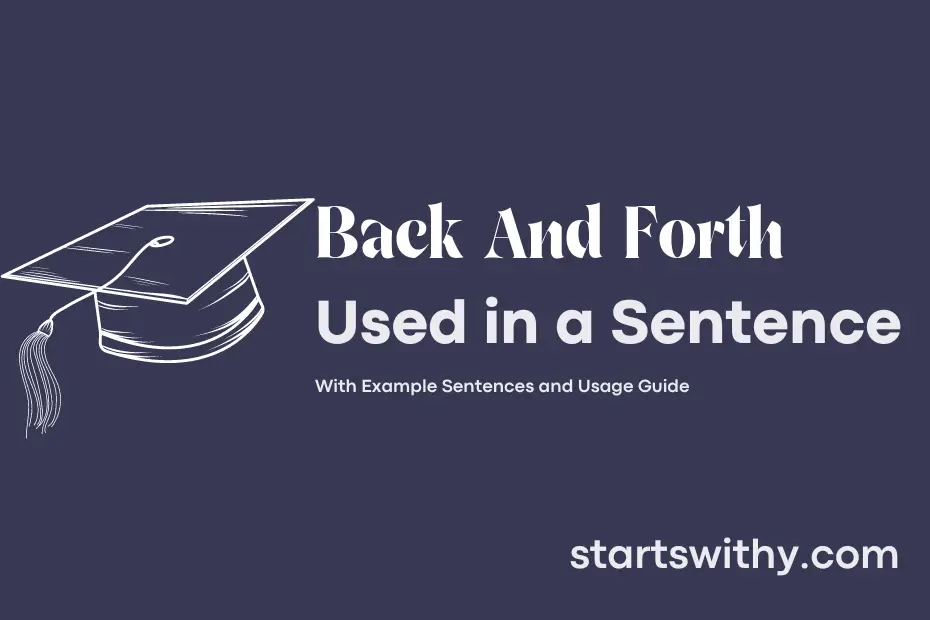Do you ever find yourself engaged in a conversation or debate where ideas are being exchanged rapidly and continuously in a lively manner? This dynamic exchange of thoughts and opinions, known as “back and forth,” forms the basis of many discussions and interactions.
In this pattern of verbal exchange, individuals take turns expressing their thoughts, responding to each other’s points, and engaging in a continual flow of dialogue. The “back and forth” nature of these interactions allows for a nuanced exploration of topics, bringing depth and insight to the conversation.
7 Examples Of Back And Forth Used In a Sentence For Kids
- The swing goes back and forth on the playground.
- We can play catch by throwing the ball back and forth.
- The fan moves back and forth to keep us cool.
- The pendulum swings back and forth in the clock.
- The boat rocks back and forth in the water.
- The seesaw goes back and forth when we take turns.
- The wipers on the car move back and forth in the rain.
14 Sentences with Back And Forth Examples
- Back and forth, the students debated the pros and cons of the new campus policy.
- After hours of back and forth discussion, the group finally settled on a topic for their presentation.
- The students passed the textbook back and forth as they took turns highlighting important information.
- Back and forth, the ideas flowed during the brainstorming session for the upcoming project.
- They went back and forth exchanging notes and studying together for the upcoming exams.
- Back and forth, they discussed their internship experiences and shared valuable insights with each other.
- The students practiced their dance routine, moving back and forth to the beat of the music.
- Back and forth, they negotiated with the professor about extending the deadline for the assignment.
- The group played a friendly game of badminton, rallying back and forth to score points.
- The students went back and forth exploring different career options before deciding on a major.
- Back and forth, they shared tips and tricks for acing the upcoming job interviews.
- They exchanged laptops, passing them back and forth to help each other troubleshoot technical issues.
- The friends took turns narrating a story, adding details back and forth to create an engaging narrative.
- The classmates debated passionately, arguing their points back and forth in a lively discussion.
How To Use Back And Forth in Sentences?
To use “Back And Forth” in a sentence, simply follow these easy steps.
-
Understand the meaning: The phrase “Back And Forth” typically refers to the movement where something is going in one direction and then the opposite direction repeatedly.
-
Identify the context: Think about a situation where there is a movement or action that involves going back and forth.
-
Choose the appropriate words: When constructing your sentence, make sure to include the phrase “Back And Forth” in the correct position to convey the desired meaning.
-
Example sentence: “The children were playing catch, throwing the ball back and forth.”
-
Practice using the phrase: Try incorporating “Back And Forth” into different sentences to become more comfortable with its usage.
-
Pay attention to punctuation: When using “Back And Forth” in a sentence, remember to include any necessary punctuation marks, such as commas or periods.
-
Avoid overuse: While it’s good to practice using new words or phrases, be mindful of not overusing “Back And Forth” in your sentences.
By following these steps, you’ll be able to confidently incorporate “Back And Forth” into your sentences and effectively communicate movement or actions that involve going in both directions.
Conclusion
In summary, using sentences with “back and forth” helps to illustrate movement or exchange between two or more entities. These sentences often depict a sense of alternation, debate, or negotiation. By incorporating this phrase into writing, it brings clarity to the dynamics of a situation where there is a continuous exchange or movement occurring.
Additionally, sentences featuring “back and forth” can add depth and rhythm to a narrative, enhancing the reader’s understanding of the interactions between characters or elements. Whether describing physical movement, emotional tug-of-war, or intellectual debate, utilizing this phrase effectively captures the essence of dynamic exchanges, making the writing more engaging and vivid.



